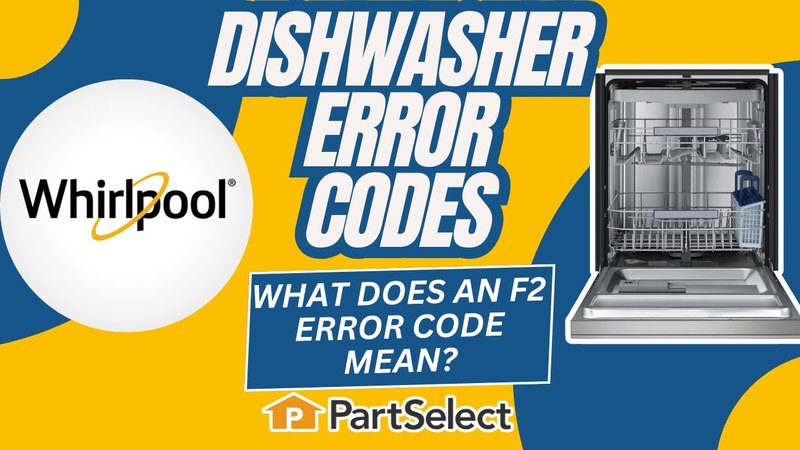
To put it in perspective, think of your dishwasher as a delicate balancing act of filling and emptying water. When there’s a hiccup in that process, you get the F2 error code. It’s like when a sink’s drain gets clogged, and you can’t get the water out no matter what you try. This error can be triggered by a few common issues, but don’t worry—most of them are fairly straightforward to tackle. Let’s dive deeper into what could be causing this pesky problem.
Understanding the Drainage System
Before we talk solutions, it’s handy to understand what goes on inside your dishwasher. The drainage system in a dishwasher works a lot like your kitchen sink but is a tad more complex. Water is pumped into the dishwasher during a cycle, it swirls around cleaning your dishes, and then it’s supposed to be pumped out, leaving behind sparkling plates and glasses. Now, if there’s a kink in this chain, you get that F2 error. Think of it as your dishwasher’s way of saying, “Hey, I tried to drain, but something’s in the way!”
In most Whirlpool dishwashers, the drainage system consists of a pump, a hose, and a filter. If any of these components get blocked or malfunction, water gets trapped inside. It’s similar to when hair clogs up a shower drain—you just have to go in and clear the blockage to get things flowing again. If you’re comfortable doing some hands-on troubleshooting, this is usually something you can do yourself. Otherwise, it’s a good idea to call in a professional who understands the ins and outs of your appliance.
Here’s the deal: the most common reason for an F2 error is a blockage in the drain hose or pump. Over time, food particles, grease, and soap residue can build up and cause a blockage. This is why regularly cleaning your dishwasher can prevent such hiccups. It’s like visiting the dentist; a regular clean can prevent a lot of pain down the line.
Clogged or Faulty Drain Hose
Let’s get to one of the major suspects: the drain hose. The drain hose is the dishwasher’s exit route for dirty water. When it’s clogged or kinked, the water can’t leave, and the machine gets stuck in its cycle. It’s like trying to sip a thick milkshake through a tiny straw—it just doesn’t work!
To check the hose, you’ll need to gently pull your dishwasher out and take a look at the back where the hose connects to both the dishwasher and the sink drain. Look for any obvious kinks or bends. You can also remove the hose and check for any obstructions by running water through it. If water doesn’t flow freely, you’ve found your issue. Sometimes, a simple cleaning is all it takes to fix this problem.
Regularly inspecting and cleaning your hose can prevent future issues. You don’t have to make it a weekly task but checking every few months can keep things running smoothly. If replacing the hose is necessary, it’s usually pretty cost-effective and can be done with a few basic tools.
Blocked Filters and Pumps
Now, onto another usual suspect: the filters and pumps. Much like the lint trap in your dryer, dishwashers have filters that catch bits of food and debris. When these get clogged, the water can’t pass through during the draining phase. It’s like trying to breathe with a stuffy nose—it just doesn’t work well.
Start by checking the filter at the bottom of your dishwasher. If you notice a lot of gunk or food particles clogging it up, give it a good clean. Remove any food scraps and rinse the filter under running water. While you’re at it, check the pump area for any obstructions. The pump is often hidden under the filter, and a visual inspection can often reveal if something is caught there.
Routine maintenance of these components can help avoid the F2 error down the line. Consider it as a bit of dish-cleaning hygiene; regular clean-ups not only prevent errors but also ensure your dishes come out sparkling every time.
Electrical or Mechanical Failures
Finally, if everything else checks out, you might be facing an electrical or mechanical failure. This is where things get a bit more technical. Sometimes, the issue might be with the control board—a bit like the brain of your dishwasher. If it goes haywire, it might send the wrong signals, causing an error code even when the drainage is fine.
If you’re comfortable with electrical work, you can try resetting your dishwasher by turning off the power for a few minutes before turning it back on. This can sometimes reset the system and clear the error. However, if the F2 code persists, you may be dealing with a faulty part that needs professional attention.
In such cases, calling in a technician is your best bet. They’ll have the tools and know-how to diagnose and replace faulty components. It’s a bit like going to see a doctor when you can’t shake a cough—sometimes, expert help is necessary to get you back on track.
Prevention and Next Steps
So, what can you do to avoid these headaches in the future? Regular maintenance is key. Clean your filters and check your hoses every few months. Think of it like car maintenance; a little effort every now and then keeps things running smoothly.
If you’re unsure about any step, refer to the user manual or get in touch with Whirlpool’s customer support. They’re there to help and can often troubleshoot issues over the phone. Also, consider scheduling an annual check-up with a professional to make sure everything is in top shape.
In conclusion, while the F2 error can be frustrating, it’s often manageable with a bit of diligence and care. By understanding how your dishwasher works and regularly checking its key components, you can keep it running efficiently and extend its lifespan. Remember, a little attention to detail today can save you from bigger problems tomorrow.